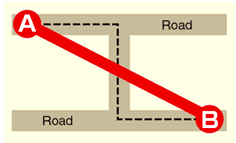 |
| New
Space for the Creation of Cities - Deep
Underground |
|
 |
 |
Utilization
of the Some benefits of the Deep Underground |
|
 |
 |
 |
Cost of using the
Deep Underground
The use of the Deep Underground results in increases in the
costs of excavating vertical shafts and constructing tunnels in comparison
with utilizing surface and shallow underground construction; however, it
enables cost reductions by making straight-line routes.
 |
 |
 |
For example, it enables cost reductions
by permitting links at the shortest distances via straight lines
between targets at locations A and B, without being affected
by linear shapes such as roads. |
|
 |
Test calculations regarding construction
utilizing the Deep Underground |
|
 |
|
Earthquake safety
In general, tremors in case of an earthquake tend to get smaller
the deeper the depth under ground. Tremors in the Deep Underground are thought
to be much weaker than at the surface of the earth; therefore, the Deep
Underground is a space that boasts higher safety against earthquakes.
|
Impact on subsurface water when
a project is executed in the Deep Underground
There are two kinds of subsurface water, non-pressured subsurface
water of shallow aquifers and pressured (artesian) underground water of
deep aquifers (aquifers = strata comprised of sand and gravel where subsurface
water flows). Pressured underground water of the Deep Underground does not
flow much, even if structures are constructed in the Deep Underground. Consequently,
it is thought that such structures rarely obstruct the flow of subsurface
water. Of course, it is always necessary to be careful in executing projects.
|
|